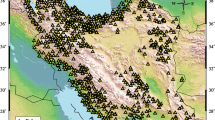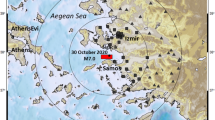Abstract
The Engineering Strong-Motion (ESM) flatfile is a parametric table which contains verified and reliable metadata and intensity measures of manually processed waveforms included in the ESM database. The flatfile has been developed within the Seismology Thematic Core Service of EPOS-IP (European Plate Observing System Implementation Phase) and it is disseminated throughout a web portal (http://esm.mi.ingv.it/flatfile-2018/flatfile.php) for research and technical purposes. The adopted criteria for flatfile compilation aim to collect strong motion data and related metadata in a uniform, updated, traceable and quality-checked way to develop Ground Motion Models (GMMs) for Probabilistic Seismic Hazard Assessment (PSHA) and engineering applications. In this paper, we present the characteristics of ESM flatfile in terms of recording, event and station distributions, and we discuss the most relevant features of the Intensity Measures (IMs) of engineering interest included in the table. The dataset for flatfile compilation includes 23,014 recordings from 2179 earthquakes and 2080 stations from Europe and Middle-East. The events are characterized by magnitudes in the range 3.5–8.0 and refer to different tectonics regimes, such as shallow active crustal and subduction zones. Intensity measures include peak and integral parameters and duration of each waveform. The spectral amplitudes of the (5% damping) acceleration and displacement response are provided for 36 periods, in the interval 0.01–10 s, as well as the 103 amplitudes of the Fourier spectrum for the frequency range 0.04–50 Hz. Several statistics are shown with reference to the most significant metadata for GMMs calibrations, such as moment magnitude, focal depth, several distance metrics, style of faulting and parameters for site characterization. Furthermore, we also compare and explain the most relevant differences between the metadata of ESM flatfile with those provided by the previous flatfile derived in RESORCE (Reference Database for Seismic Ground Motion in Europe) project.
















Similar content being viewed by others
References
Aki K, Richards PG (2009) Quantitative seismology, 2nd edn. University Science Books, Mill Valley. ISBN 978-1891389634
Akkar S, Bossu R, Cauzzi C, Clinton J, D’Amico M, Van Eck T, Frobert L, Godey S, Gueguen P, Kästli P, Luzi L, Pacor F, Pequegnat C, Puglia R, Russo E, Sleeman R (2014a) Network of European research infrastructures for earthquake risk assessment and mitigation (NERA)–networking accelerometric networks and Sm data users (NA3). In Second European conference on earthquake engineering and seismology, Istanbul
Akkar S, Sandıkkaya MA, Şenyurt M, Sisi AA, Ay BÖ, Traversa P, Douglas J, Cotton F, Luzi L, Hernandez B, Godey S (2014b) Reference database for seismic ground-motion in Europe (RESORCE). Bull Earthq Eng 12(1):311–339
Al-Atik L, Abrahamson NA, Bommer JJ, Scherbaum F, Cotton F, Kuehn N (2010) The variability of ground-motion prediction models and its components. Seismol Res Lett 81(5):794–801
Ambraseys N, Smit P, Sigbjornsson R, Suhadolc P, Margaris B (2002) Internet-site for European strong motion Data, European Commission, Research-Directorate General, environment and climate programme
Ambraseys N, Smit P, Douglas J, Margaris B, Sigbjornsson R, Olafsson S, Suhadolc P, Costa G (2004) Internet-Site for European strong motion data. Bollettino di Geofisica Teorica ed Applicata 45(3):113–129
Ancheta TD, Darragh RB, Stewart JP, Seyhan E, Silva WJ, Chiou BSJ, Wooddell KE, Graves RW, Kottke AR, Boore DM, Kishida T (2014) NGA-West2 database. Earthq Spectra 30(3):989–1005
Anderson JG (2010) Source and site characteristics of earthquakes that have caused exceptional ground accelerations and velocities. Bull Seismol Soc Am 100(1):1–36
Atkinson GM, Yenier E, Sharma N, Convertito V (2016) Constraints on the near-distance saturation of ground-motion amplitudes for small-to-moderate induced earthquakes. Bull Seismol Soc Am 106(5):2104–2111
Beresnev IA, Wen KL (1996) Nonlinear soil response—a reality? Bull Seismol Soc Am 86(6):1964–1978
Bindi D, Weatherill G, Kotha S-R, Lanzano G, Luzi L, Cotton F (2018a) The pan-European engineering strong motion (ESM) flatfile: consistency check via residual analysis. Bull Earthquake Eng. https://doi.org/10.1007/s10518-018-0466-x
Bindi D, Spallarossa D, Picozzi M, Scafidi D, Cotton F (2018b) Impact of magnitude selection on aleatory variability associated with ground motion prediction equations: part I—local, energy and moment magnitude calibration and stress drop variability in central Italy. Bull Seismol Soc Am 108:1427–1442. https://doi.org/10.1785/0120170356
Boore DM (2010) Orientation-independent, nongeometric-mean measures of seismic intensity from two horizontal components of motion. Bull Seismol Soc Am 100(4):1830–1835
Boore DM, Joyner WB (1997) Site amplifications for generic rock sites. Bull Seismol Soc Am 87(2):327–341
CEN (2004) EuroCode 8: design of structures for earthquake resistance—part 1: general rules, seismic actions and rules for buildings. European Committee for Standardization, Bruxelles
Cosenza E, Manfredi G (2000) Damage indices and damage measures. Prog Struct Mater Eng 2(1):50–59
Di Capua G, Lanzo G, Pessina V, Peppoloni S, Scasserra G (2011) The recording stations of the Italian strong motion network: geological information and site classification. Bull Earthq Eng 9(6):1779–1796
Douglas J (2018) Capturing geographically varying uncertainty in earthquake ground motion models or what we think we know may change. In: Proceedings of the 16th European conference on earthquake engineering, 18–21 June, Thessaloniki, Greece
Douglas J, Boore DM (2011) High-frequency filtering of strong-motion records. Bull Earthq Eng 9(2):395–409
Douglas J, Akkar S, Ameri G, Bard PY, Bindi D, Bommer JJ, Bora SS, Cotton F, Derras B, Hermkes M, Kuehn NM, Luzi L, Massa M, Pacor F, Riggelsen C, Sandıkkaya MA, Scherbaum F, Stafford PJ, Traversa P (2014) Comparisons among the five ground-motion models developed using RESORCE for the prediction of response spectral accelerations due to earthquakes in Europe and the Middle East. Bull Earthq Eng 12(1):341–358
Felicetta C, D’Amico M, Lanzano G, Puglia R, Russo E, Luzi L (2017) Site characterization of Italian accelerometric stations. Bull Earthq Eng 15(6):2329–2348
Garcia D, Wald DJ, Hearne MG (2012) A global earthquake discrimination scheme to optimize ground-motion prediction equation selection. Bull Seismol Soc Am 102(1):185–203
Grünthal G, Wahlström R (2012) The European-Mediterranean earthquake catalogue (EMEC) for the last millennium. J Seismol 16(3):535–570
Grünthal G, Wahlström R, Stromeyer D (2009a) The unified catalogue of earthquakes in central, northern and northwestern Europe (CENEC)—updated and expanded to the last millennium. J Seismol 13:517–541
Grünthal G, Stromeyer D, Wahlström R (2009b) Harmonization check of Mw within the central, northern and northwestern European earthquake catalogue (CENEC). J Seismol 13:613–632
Kaklamanos J, Baise LG, Boore DM (2011) Estimating unknown input parameters when implementing the NGA ground-motion prediction equations in engineering practice. Earthq Spectra 27(4):1219–1235
Konno K, Ohmachi T (1998) Ground-motion characteristics estimated from spectral ratio between horizontal and vertical components of microtremor. Bull Seismol Soc Am 88(1):228–241
Lanzano G, W8.4-ESM and W8.6-GMPE EPOS working groups Team (2018) Characteristics of the engineering strong motion flatfile for ground motion prediction equations selection in Europe. In: Proceedings of the 16th European conference on earthquake engineering, 18–21 June, Thessaloniki, Greece, paper no 10467
Lanzano G, D’Amico M, Felicetta C, Puglia R, Luzi L, Pacor F, Bindi D (2016) Ground motion prediction equations for region specific probabilistic seismic hazard analysis. Bull Seismol Soc Am 106(1):73–92
Lanzano G, D’Amico M, Felicetta C, Luzi L, Puglia R (2017) Update of the single-station sigma analysis for the Italian strong motion stations. Bull Earthq Eng 15(6):2411–2428
Luzi L, Puglia R, Russo E, D’Amico M, Felicetta C, Pacor F, Lanzano G, Çeken U, Clinton J, Costa G, Duni L, Farzanegan E, Gueguen P, Ionescu C, Kalogeras I, Özener H, Pesaresi D, Sleeman R, Strollo A, Zare M (2016) The Engineering strong motion database: a platform to access Pan-European accelerometric data. Seismol Res Lett 87(4):987–997
Luzi L, Pacor F, Puglia R, Lanzano G, Felicetta C, D’Amico M, Michelini A, Faenza L, Lauciani V, Iervolino I, Baltzopoulos G, Chioccarelli E (2017) The central Italy seismic sequence between august and december 2016: analysis of strong-motion observations. Seismol Res Lett 88(5):1219–1231
Oth A, Miyake H, Bindi D (2017) On the relation of earthquake stress drop and ground motion variability. J Geophys Res 122:5474–5492
Pacor F, Paolucci R, Ameri G, Massa M, Puglia R (2011a) Italian strong motion records in ITACA: overview and record processing. Bull Earthq Eng 9:1741–1759. https://doi.org/10.1007/s10518-011-9295-x
Pacor F, Paolucci R, Luzi L, Sabetta F, Spinelli A, Gorini A, Nicoletti M, Marcucci S, Filippi L, Dolce M (2011b) Overview of the Italian strong motion database ITACA 1.0. Bull Earthq Eng 9(6):1723–1739
Pacor F, Felicetta C, Lanzano G, Sgobba S, Puglia R, D’Amico M, Russo E, Baltzopoulos G, Iervolino I (2018) NESS v1.0: a worldwide collection of strong-motion data to investigate near source effects. Seismol Res Lett. https://doi.org/10.1785/0220180149
Paolucci R, Pacor F, Puglia R, Ameri G, Cauzzi C, Massa M (2011) Record processing in ITACA, the new Italian strong motion database. In: Akkar S, Gülkan P, van Eck T (eds) Earthquake data in engineering seismology-predictive models, data management and networks. Springer, Dordrecht, pp 99–113 [(printed version) 978-94-007-0152-6 (e-book version)]. ISBN 978-94-007-0151-9
Puglia R, Russo E, Luzi L, D’Amico M, Felicetta C, Pacor F, Lanzano G (2018) Strong motion processing service: a tool to access and analyse earthquakes strong motion waveforms. Bull Earthq Eng 16(7):2641–2651
Santucci de Magistris F, Lanzano G, Forte G, Fabbrocino G (2013) A database for PGA threshold in liquefaction occurrence. Soil Dyn Earthq Eng 54:17–19
Schmedes J, Archuleta RJ (2008) Near-source ground motion along strike-slip faults: insights into magnitude saturation of PGV and PGA. Bull Seismol Soc Am 98(5):2278–2290
Trifunac MD, Brady AG (1975) A study on the duration of strong earthquake ground motion. Bull Seismol Soc Am 65(3):581–626
Wald DJ, Allen TI (2007) Topographic slope as a proxy for seismic site conditions and amplification. Bull Seismol Soc Am 97(5):1379–1395
Weatherill G, Bindi D, Cotton F, Danciu L, Luzi L (2018) Building a new ground motion logic tree for Europe: needs, challenges and new opportunities from European seismological data. In: Proceedings of the 16th European conference on earthquake engineering, 18–21 June, Thessaloniki, Greece
Zafarani H, Soghrat MR (2017) A selected dataset of the Iranian strong motion records. Nat Hazards 86(3):1307–1332
Zhao JX, Zhou S, Gao P, Long T, Zhang Y, Thio HK, Lu M, Rhoades DA (2015) An earthquake classification scheme adapted for Japan determined by the goodness of fit for ground-motion prediction equations. Bull Seismol Soc Am 105(5):2750–2763
Zhu TJ, Tso WK, Heidebrecht AC (1988) Effect of peak ground a/v ratio on structural damage. J Struct Eng 114(5):1019–1037
Author information
Authors and Affiliations
Corresponding author
Rights and permissions
About this article
Cite this article
Lanzano, G., Sgobba, S., Luzi, L. et al. The pan-European Engineering Strong Motion (ESM) flatfile: compilation criteria and data statistics. Bull Earthquake Eng 17, 561–582 (2019). https://doi.org/10.1007/s10518-018-0480-z
Received:
Accepted:
Published:
Issue Date:
DOI: https://doi.org/10.1007/s10518-018-0480-z




